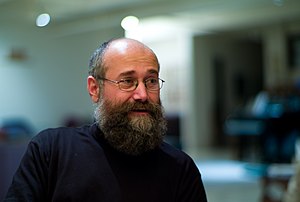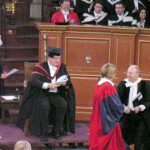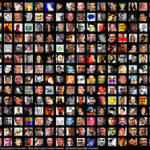
- Image via Wikipedia
I’ve just been re-reading Howard’s chapter in Freesouls… And this section really resonates in relation to the use of Web 2.0 (or “participatory media” if you like) in teaching and learning… One thing it assumes is a proactive commitment from participants… Engagement…
This passage suggests to me a compelling rationale for the use of these opportunities in teaching and learning…
Participatory media include (but aren’t limited to) blogs, wikis, RSS, tagging and social bookmarking, music-photo-video sharing, mashups, podcasts, digital storytelling, virtual communities, social network services, virtual environments, and videoblogs. These distinctly different media share three common, interrelated characteristics:
- Many-to-many media now make it possible for every person connected to the network to broadcast as well as receive text, images, audio, video, software, data, discussions, transactions, computations, tags, or links to and from every other person. The asymmetry between broadcaster [teacher?] and audience [learner?] that was dictated by the structure of pre-digital technologies has changed radically. This is a technical- structural characteristic.
- Participatory media are social media whose value and power derives from the active participation of many people. Value derives not just from the size of the audience, but from their power to link to each other, to form a public as well as a market. This is a psychological and social characteristic.
- Social networks, when amplified by information and communication networks, enable broader, faster, and lower cost coordination of activities. This is an economic and political characteristic.
Then I glance at Yochai Benkler’s words…
Contemporary life is not chaotic, in the colloquial sense we apply to disaster zones. It is, however, complex and rapidly changing; much more so than life was in the past; even the very near past. Life, of course, was never simple. But the fact that day-to-day behaviours in Shenzhen and Bangalore have direct and immediate effects on people from Wichita to Strasbourg, from Rio de Janeiro to Sydney, or that unscrupulous lenders and careless borrowers in the United States can upend economic expectations everywhere else in the world, no matter how carefully others have planned, means that there are many more moving parts that affect each other. And from this scale of practical effects, complexity emerges. New things too were ever under the sun; but the systematic application of knowledge to the creation of new knowledge, innovation to innovation, and information to making more information has become pervasive; and with it the knowledge that next year will be very different than this. The Web, after all, is less than a generation old.
These two features?the global scale of interdependence of human action, and the systematic acceleration of innovation, make contemporary life a bit like a slow motion disaster, in one important respect. Its very unpredictability makes it unwise to build systems that take too much away from what human beings do best: look, think, innovate, adapt, discuss, learn, and repeat…
The set of human systems necessary for action in this complex, unpredictable set of conditions, combining rationalization with human agency, learning and adaptation, is as different from managed systems and perfect markets as the new Toyota is from the old General Motors, or as the Internet now is from AT&T then. The hallmarks of these newer systems are: (a) location of authority and practical capacity to act at the edges of the system, where potentialities for sensing the environment, identifying opportunities and challenges to action and acting upon them, are located; (b) an emphasis on the human: on trust, cooperation, judgment and insight; (c) communication over the lifetime of the interaction; and (d) loosely-coupled systems: systems in which the regularities and dependencies among objects and processes are less strictly associated with each other; where actions and interactions can occur through multiple systems simultaneously, have room to fail, manoeuvre, and be reoriented to fit changing conditions and new learning, or shift from one system to another to achieve a solution…
To deal with the new complexity of contemporary life we need to re-introduce the human into the design of systems. We must put the soul back into the system. If years of work on artificial intelligence have taught us anything, it is that what makes for human insight is extremely difficult to replicate or systematize. At the center of these new systems, then, sits a human being who has a capacity to make judgments, experiment, learn and adapt. But enabling human agency also provides scope of action for human frailty. Although this idea is most alien to the mainstream of system design in the twentieth century, we must now turn our attention to building systems that support human sociality?our ability to think of others and their needs, and to choose for ourselves goals consistent with a broader social concern than merely our own self-interest. The challenge of the near future is to build systems that will allow us to be largely free to inquire, experiment, learn and communicate, that will encourage us to cooperate, and that will avoid the worst of what human beings are capable of, and elicit what is best. Free software, Wikipedia, Creative Commons and the thousands of emerging human practices of productive social cooperation in the networked information economy give us real existence proofs that human-centric systems can not merely exist, but thrive, as can the human beings and social relations that make them.
http://freesouls.cc/essays/06-yochai-benkler-complexity-and-humanity.html
..and reflect on our discussion this week… And Isaac Mao comes into focus…and I am inspired by his vision of Sharism as a goal for education and life more generally…
With the People of the World Wide Web communicating more fully and freely in Social Media while rallying a Web 2.0 content boom, the inner dynamics of such a creative explosion must be studied more closely. What motivates those who join this movement and what future will they create? A key fact is that a superabundance of community respect and social capital are being accumulated by those who share. The key motivator of Social Media and the core spirit of Web 2.0 is a mind switch called Sharism. Sharism suggests a re-orientation of personal values. We see it in User Generated Content. It is the pledge of Creative Commons. It is in the plans of future-oriented cultural initiatives. Sharism is also a mental practice that anyone can try, a social-psychological attitude to transform a wide and isolated world into a super-smart Social Brain…
The first type of reward that you will get comes in the form of comments. Then you know you’ve provoked interest, appreciation, excitement. The second reward is access to all the other stuff being shared by friends in your network. Since you know and trust them, you will be that much more interested in what they have to share. Already, the return is a multiple of the small meme you first shared. But the third type of return is more dramatic still. Anything you share can be forwarded, circulated and republished via other people’s networks. This cascade effect can spread your work to the networked masses…
The more people who create in the spirit of Sharism, the easier it will be to attain well- balanced and equitable Social Media that is woven by people themselves. Media won’t be controlled by any single person but will rely on the even distribution of social networking. These “Shaeros” (Sharing Heroes) will naturally become the opinion leaders in the first wave of Social Media. However, these media rights will belong to everyone. You yourself can be both producer and consumer in such a system.
Related articles by Zemanta
- Social Discovery, Social Filtering, and other Web-Squared Shapes (everwas.com)
- Obama, Kids, & All Tomorrow’s Web Apps: President Focuses on Tech Education (readwriteweb.com)
- Social Media 101– Open content licensing (k1v1n.com)
- How to build a Social Networking Website with Drupal (woorkup.com)
- NPAR: building networked participatory action research in cyberspace (slideshare.net)
![Reblog this post [with Zemanta]](http://img.zemanta.com/reblog_a.png?x-id=1519d733-d5ec-8e7a-951a-c3f98a779292)






One thought on “FREE time for FreeSouls… a vison for the future of education NOW…”